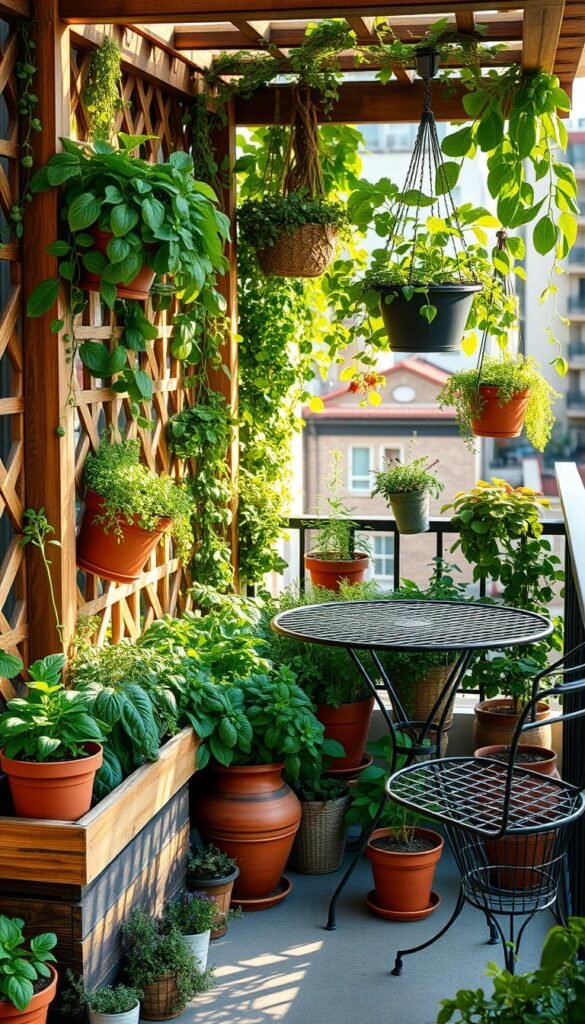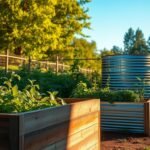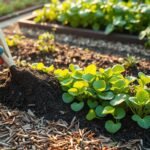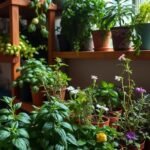Who says you need a backyard to grow tasty greens? Urban living doesn’t have to mean sacrificing the joy of nurturing your own food. With smart planning and the right tools, even compact spaces can become lush, productive areas bursting with flavor.
Imagine stepping outside your door to snip herbs for dinner or harvest cherry tomatoes still warm from the sun. Container plants thrive in small footprints, letting you create vertical gardens or window box displays. All it takes is understanding sunlight patterns, choosing suitable varieties, and mastering simple care routines.
This guide walks you through everything from selecting durable pots to creating efficient watering systems. You’ll learn how to maximize every inch while avoiding common pitfalls like overcrowding or poor drainage. We’ve included budget-friendly solutions alongside premium upgrades for those ready to level up their green thumb game.
Whether you’re working with a fire escape or a full patio, these strategies help you build resilience against grocery store shortages and connect with nature daily. Let’s turn that concrete corner into your personal produce section!
Understanding Your Balcony Garden Space
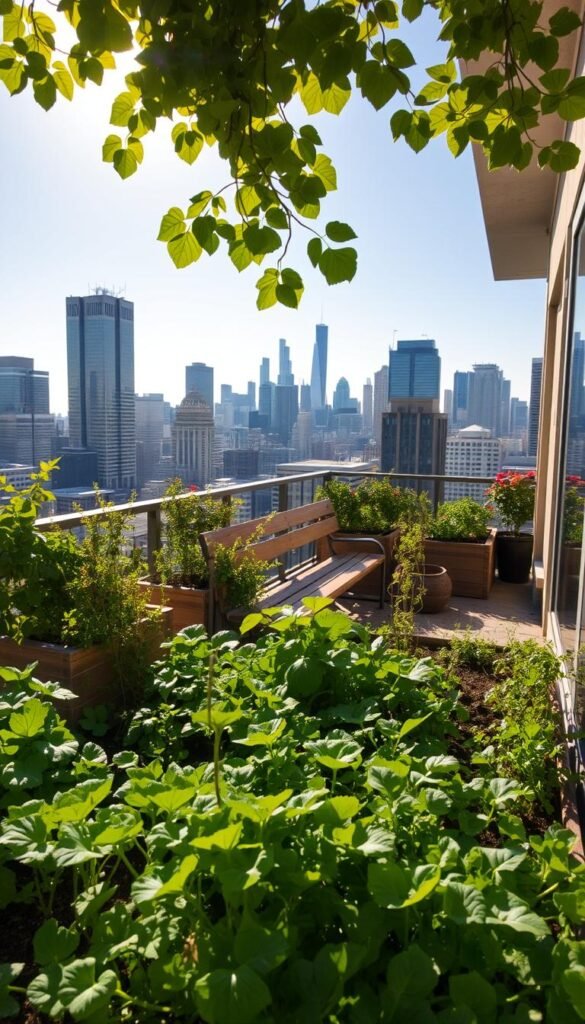
Your outdoor area holds hidden potential waiting to be unlocked. Before picking up a trowel, take time to decode your unique growing environment. This detective work ensures your green efforts yield delicious rewards.
Sunlight Patterns and Climate Considerations
Track how sunlight moves across your area through the day. Use a free app like Sun Surveyor or simply note shadows hourly. Most edibles need six hours of direct sun, but leafy greens often thrive with less.
Plug your zip code into garden.org’s zone finder to discover your USDA Hardiness Zone. This reveals frost dates and ideal planting windows. San Francisco gardeners might juggle three microclimates on one fire escape!
Creative Space Solutions
Turn walls into edible displays with pocket planters or hanging baskets. Rail-mounted boxes free up floor space for larger containers. Try stacking pots or using tiered shelves to create vertical layers.
Match crops to your conditions. Windy spots? Sturdy kale or dwarf fruit trees handle gusts better than delicate lettuces. Partial shade? Swiss chard and mint won’t mind. Remember: success starts with working smarter, not harder.
Selecting Containers and Planters for Your Garden
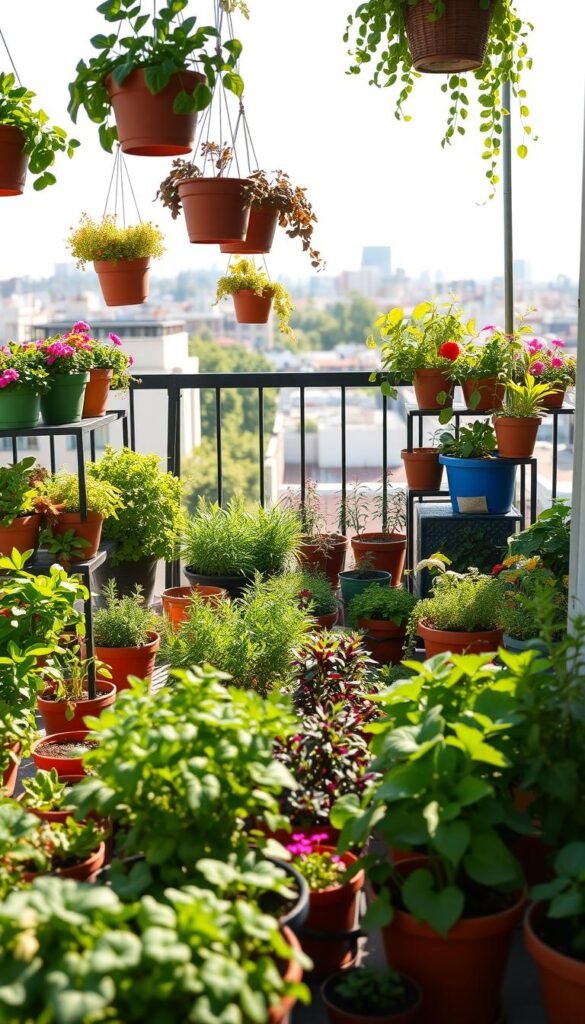
Your plant’s home matters as much as sunlight or water. The right containers balance function and style while keeping roots happy. Let’s break down your options and craft solutions that fit your space like a glove.
Types of Pots, Planters, and Railing Solutions
Clay pots breathe better than plastic but dry out faster. Self-watering planters with reservoirs cut maintenance for busy urbanites. Rail-mounted boxes? Perfect for strawberries or trailing herbs.
Prioritize drainage holes in every container—no exceptions. For heavy feeders like tomatoes, choose 5-gallon buckets or fabric grow bags. Size impacts yields: shallow pots suit radishes, while deep ones support carrots.
DIY Options and Creative Container Ideas
Turn an old shoe organizer into a vertical herb wall. Drill holes in wine crates for rustic window boxes. Upcycled milk jugs become mini greenhouses for seedlings.
Apartment dwellers, watch your weight! Lightweight coconut coir planters beat concrete urns on high floors. Pair hanging baskets with best plants for tight spaces like cherry tomatoes or nasturtiums.
Remember: mismatched containers create charm. Mix terracotta with galvanized steel for visual texture. Just ensure each vessel serves your plants’ needs first.
Balcony Vegetable Garden: Must-Have Gear for Successful Apartment Growing
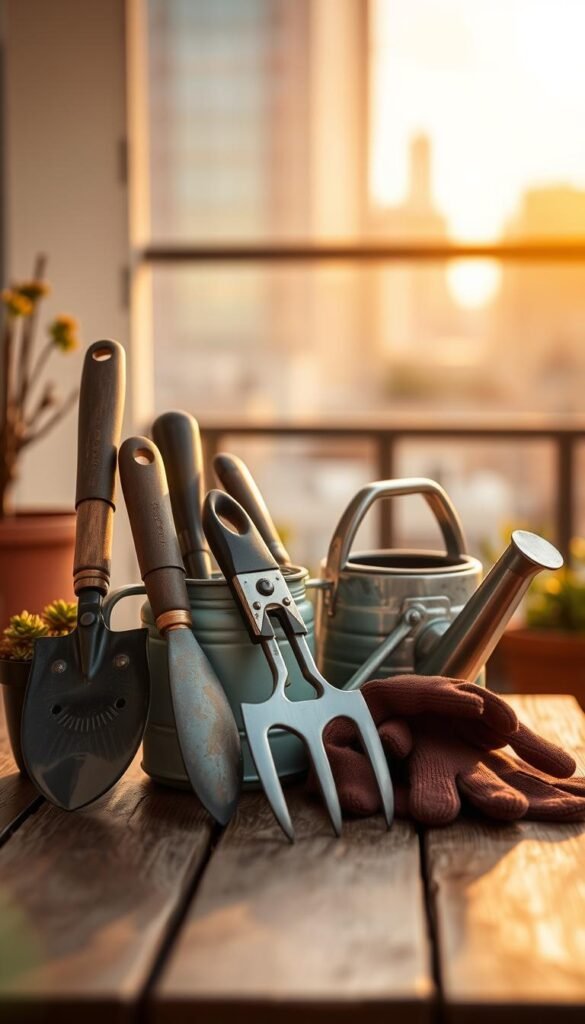
The right equipment transforms cramped corners into thriving green spaces. Start with three basics: a stainless steel trowel for digging, sharp bypass pruners for clean cuts, and a 2-gallon watering can with a long spout. These time-saving tools handle 90% of daily tasks while fitting neatly under a bench.
Compact versions of traditional tools make all the difference. Look for collapsible hoses that coil into shoeboxes and hand rakes designed for tight spots. Soil testers like pH meters take the guesswork out of plant care—simply probe the dirt to check moisture and nutrient levels.
Smart storage keeps your space organized. Magnetic strips hold metal tools vertically, while foldable fabric caddies tuck into corners. As this apartment gardening guide notes, quality gear pays off through multiple growing seasons. A sturdy potting mat protects floors during messy repotting sessions too.
Remember: your tools should work harder than you do. Ergonomic handles reduce hand fatigue, while self-watering pots maintain consistent moisture. With these solutions, you’ll spend less time managing supplies and more time enjoying your lush, edible oasis.
Preparing Your Soil and Fertilizer Essentials
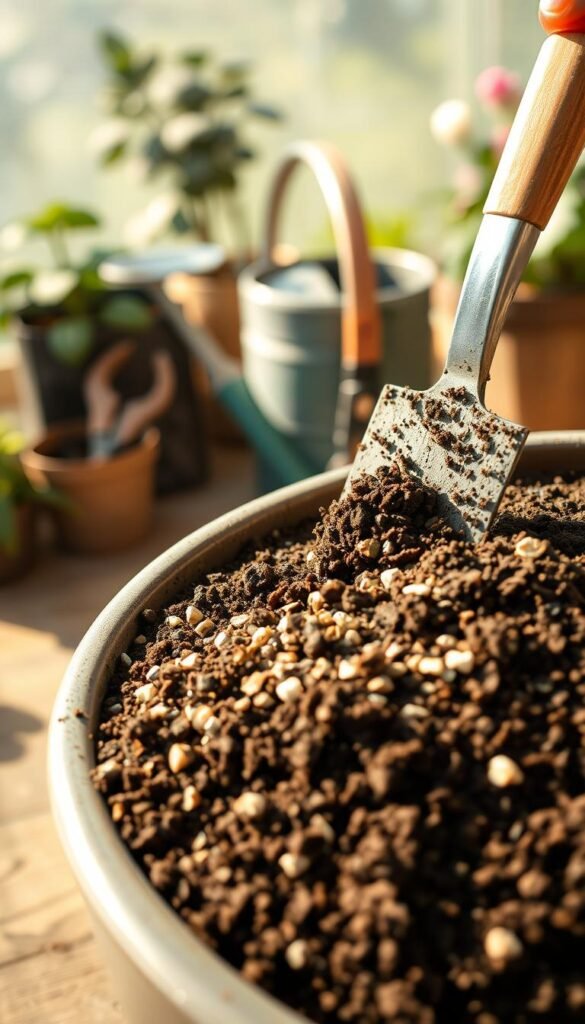
Think of your container plants as gourmet diners—they deserve a five-star meal. The right blend of nutrients and pH balance determines whether your greens thrive or merely survive. Start with quality potting soil, never regular dirt. Bagged mixes drain better and weigh less, crucial for elevated spaces.
Organic vs. Quick-Release Fertilizers
Slow-release organic options feed roots gradually. Crushed eggshells add calcium over months, while banana peels boost potassium. These work well for herbs like basil that don’t need constant attention.
Need faster results? Water-soluble formulas like Miracle-Gro 24-8-16 deliver nitrogen within days. Perfect for kale or spinach! But switch to balanced 18-18-21 blends when growing tomatoes—too much nitrogen creates leafy bushes without fruit.
Balancing pH with Garden Lime and Additives
Peat moss and compost often make soil too acidic. Sprinkle garden lime when mixing your potting blend or scatter it atop existing containers. Most edibles prefer slightly alkaline conditions (pH 6.0-7.0).
Test your soil monthly. If leaves yellow despite proper feeding, acidic conditions might be locking nutrients away. A handful of lime adjusts the chemistry without harsh chemicals.
Choosing the Ideal Vegetables and Herbs
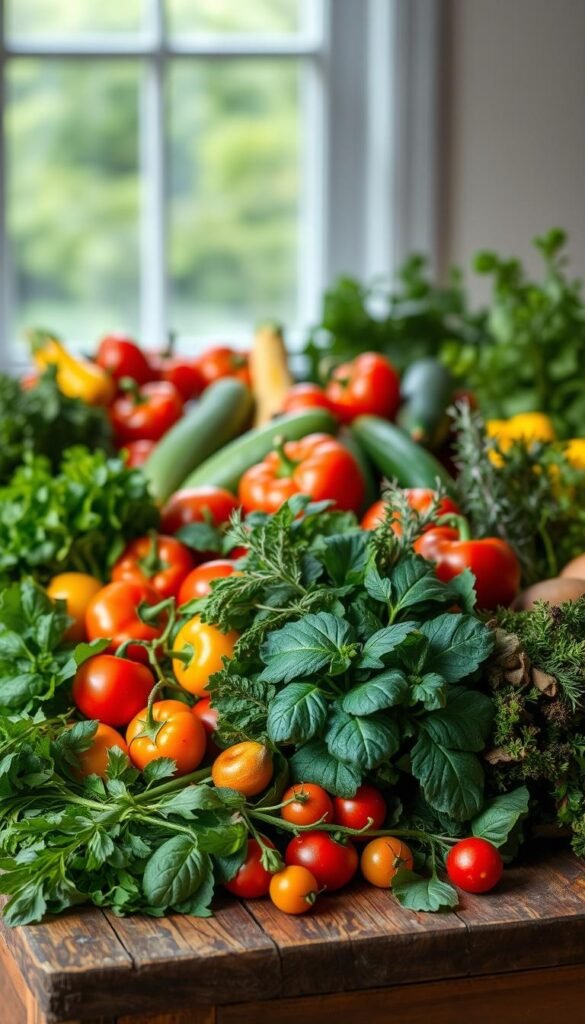
Your culinary preferences shape your edible oasis more than you think. Focus on flavors you’ll actually use while prioritizing plants that keep giving. This approach turns limited space into a nonstop harvest station.
Leafy Greens, Salad Favorites, and Quick-Grow Options
Swiss chard steals the show with rainbow stems and tender leaves. Unlike tougher kale varieties, it thrives through temperature swings. Pair it with peppery arugula—ready to pick in just three weeks.
Butterhead lettuce grows faster than you can eat it. Snip outer leaves daily for sandwiches. Prefer bold flavors? Mustard greens add zing to stir-fries while resisting pests better than spinach.
Tomatoes, Cucumbers, and Other Fruit Vegetables
Indeterminate tomato types like Sweet Million yield pints of snacks weekly once established. Use tall cages to support vines that produce until frost. Pro tip: Start seeds indoors early to shorten waiting time.
Cucumbers demand attention but repay it generously. Keep soil consistently moist and train vines up trellises. Compact bush varieties work best when floor space is scarce.
Don’t overlook herbs that thrive in partial light. Oregano and thyme handle afternoon shade, while mint conquers corners with minimal care. Just give invasive herbs their own pots to prevent takeover.
Setting Up a Drip Irrigation System
Stop hauling watering cans and embrace precision hydration. A drip setup transforms how you care for your green companions, delivering moisture exactly where roots need it most. This method slashes daily chores while boosting plant health—win-win for busy growers.
Main and Secondary Plumbing Components
Start with 1/2-inch tubing as your water highway. This primary line connects to your faucet via a vacuum breaker and pressure regulator—critical parts preventing backflow and pressure surges. Branch off with 1/4-inch micro-tubing featuring emitters spaced every 6 inches.
Hot water becomes your secret weapon here. Dip vinyl connectors briefly to soften them for snug fits. Use T-joints for splitting lines and L-shapes for corners. End each run with valves to control flow to specific plant groups.
Benefits and Tips for Efficient Watering
Leafy crops stay disease-free when water avoids their foliage. Roots grow stronger searching for steady moisture, unlike the feast-or-famine cycle of manual watering. Consistency matters more than quantity—set timers for 5-10 minute sessions at dawn.
Customizing Your Irrigation Layout
Sketch your space first. Map container locations and group plants by thirst levels. Route main lines along railings, dropping micro-tubing to individual pots. Leave slack for seasonal rearrangements—your system should evolve with your green oasis.
Allocate two days for assembly. Test each zone separately before full operation. You’ll reclaim hours weekly while watching your plants thrive like never before.
Watering, Mulching, and General Plant Care
Keep your green friends thriving with smart hydration and protective layers. Timing and technique determine whether your efforts blossom or wilt. Let’s explore how to maintain healthy growth through every phase.
Seasonal Watering Strategies
Adjust your routine as temperatures shift. During spring and fall, soak roots once weekly. Summer demands lighter sessions every two weeks to prevent waterlogging. Always check soil moisture first—if the top inch feels dry, it’s go time.
| Season | Frequency | Pro Tip |
|---|---|---|
| Spring/Fall | Weekly | Water deeply to encourage strong roots |
| Summer | Biweekly | Morning sessions reduce evaporation |
Premium Straw Mulch works magic in tight spaces. Spread a 1-inch layer to lock in moisture and block weeds. Unlike bark chips, this split-cut version won’t overwhelm your containers.
Snip yellowing leaves promptly—especially during heatwaves. Regular pruning directs energy to fruit production instead of struggling foliage. Spot drooping stems? Test soil before reaching for the watering can. Overeager care often causes more harm than neglect.
Consistency beats quantity. Establish check-up routines: inspect leaves daily, probe soil weekly, and refresh mulch monthly. Your plants will reward you with vibrant colors and steady harvests all season long.
Incorporating Vertical and Space-Saving Gar
Reach new heights by stacking your green investments vertically. Wall-mounted planters turn blank surfaces into living walls bursting with herbs like thyme or oregano. Hanging baskets let trailing cherry tomatoes cascade downward, freeing floor space for bushier crops.
Tiered shelving systems multiply your growing area without expanding footprints. Place shade-tolerant greens on lower levels and sun-lovers up top. Foldable trellises lean against walls to support peas or cucumbers, then collapse when not needed.
Try magnetic spice tins for growing microgreens on fridge doors. Upcycle old ladders into plant stands—each rung holds a different container. These solutions improve air circulation while making watering accessible at eye level.
Rotate pots weekly to ensure even light exposure. Use adjustable hooks to tilt planters toward sunlight as seasons change. With clever vertical arrangements, you’ll harvest more from your square footage than ever thought possible.
